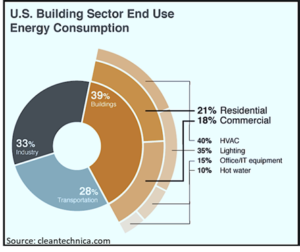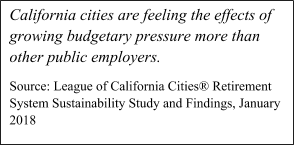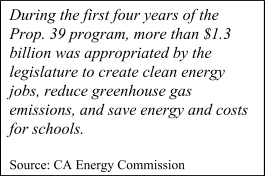By: Climatec
This September, Gov. Jerry Brown made a historic commitment to clean energy when he signed SB 100, which sets a target of 100 percent carbon-free electricity by 2045, as well as milestone targets of 50 percent renewable energy by 2026 and 60 percent renewable energy by 2030. SB 100 is a continuation of California’s strategic efforts to decarbonize its grid which, in 2017 alone, led to the investment of $1.4 billion in California companies that focus on clean energy technology.
At the same time, California’s emissions trading system continues its march toward carbon reduction, with plans to reduce greenhouse gas emissions 40 percent by 2030.
In contrast to command-and-control environmental regulations, emissions trading, or  cap and trade (CAT), provides an economic framework for reducing pollution—by taxing pollution at the source—and allows organizations to decide how to best achieve carbon-reduction targets. In California, CAT programs have collected billions of dollars for State coffers. Much of that money has been earmarked for the high-speed rail project – now at double its initial projected cost and at least four years behind schedule. However, Governor-elect Gavin Newsom has indicated his openness to retargeting funds toward energy initiatives.
cap and trade (CAT), provides an economic framework for reducing pollution—by taxing pollution at the source—and allows organizations to decide how to best achieve carbon-reduction targets. In California, CAT programs have collected billions of dollars for State coffers. Much of that money has been earmarked for the high-speed rail project – now at double its initial projected cost and at least four years behind schedule. However, Governor-elect Gavin Newsom has indicated his openness to retargeting funds toward energy initiatives.
Although Sacramento continues to refine and enhance environmental standards in the areas of energy efficiency and greenhouse gas reduction, Sacramento has not provided economic incentives for municipalities to retrofit or update old, inefficient public facilities. This is a huge missed opportunity.
California’s Existing Buildings Present an Energy Efficiency Challenge
California is a world leader in improving building efficiency through landmark climate policies, including AB 32, AB 758 and SB 350, as well as building standards, such as Title 24, that apply to new construction or major renovations. While these regulations have been effective at improving building efficiency for new construction, they often do not apply to existing buildings, which are typically decades old and highly inefficient, consuming massive amounts of energy while contributing significantly to California’s carbon emissions. The scale of this challenge is daunting. The California Energy Commission estimates that, by 2022, 50 percent of buildings will have been constructed prior to 1970 and more than 70 percent will have been constructed prior to 1990! These old structures dominate California’s inventory of highly inefficient public building energy hogs.
The majority of California cities—cash-strapped, with hundreds of millions of dollars of  deferred maintenance costs—are hampered by highly energy-inefficient buildings, facilities and infrastructure, including energy-intensive, mission-critical facilities such as water pollution control plants and police/fire services. These types of facilities not only require 24/7 energy-use but also provide ideal opportunities to achieve substantial reductions in energy consumption and carbon reductions. The equipment, technology, and expertise to upgrade these facilities is readily available in the market, yet progress towards significant “deep retrofits” is painfully slow.
deferred maintenance costs—are hampered by highly energy-inefficient buildings, facilities and infrastructure, including energy-intensive, mission-critical facilities such as water pollution control plants and police/fire services. These types of facilities not only require 24/7 energy-use but also provide ideal opportunities to achieve substantial reductions in energy consumption and carbon reductions. The equipment, technology, and expertise to upgrade these facilities is readily available in the market, yet progress towards significant “deep retrofits” is painfully slow.
Even a lay person who recently has walked around any typical state, county or city facility (particularly one that is more than 20 years old) can see that there are tremendous amounts of visible, deferred maintenance and under-investment. What that individual cannot see, however, are the potential huge and lasting economic savings lost every day by NOT doing deep, energy-efficient retrofits to all of the old and antiquated energy-consuming equipment “behind the curtains”; in the basement and on the roof.
While local governments understand and recognize the need for facility and infrastructure improvements, the pace of deployment of energy efficiency and renewable energy in existing public buildings currently is hindered by multiple issues: lack of up-front capital, status quo and natural inertia, interdepartmental competition for existing resources, piecemeal or incremental approaches, and organizational distractions around bigger issues like unfunded pension liabilities. There is also a fundamental lack of targeted funding or state grant incentives to help “prime the pump” and overcome the aforementioned barriers. There also is competition for investments in “shinier solutions” like solar, battery storage, Smart City technologies, micro-grids, fuel cells and other interesting and cool technologies. Yet, conserving a kWh of electricity or a therm of gas should be the lowest-hanging fruit to pursue from both an economic and a commonsense standpoint. Additionally, some cities turn to more studies and consultants rather than concrete project implementation, focusing on Climate Action Plans funded by grant money; these plans often consume more energy in printing and computer power than they actually save, while sitting quietly on a shelf with a belief that real work has been done.
In the face of these challenges, a fair question is, “How can Sacramento legislate and mandate very aggressive and ambitious greenhouse gas (GHG) reductions without targeting and addressing the very buildings and facilities in which they and other public officials work?”
To meet our climate goals, there is a critical need for investment to create a catalyst to overcome capital costs and inertia to retrofit existing buildings with both energy-efficiency measures….. followed by renewable energy, energy storage and other energy-targeted technologies.
Investments Needed for Local Governments to Lead by Example
In order to achieve California’s important energy and climate action policies, swift action and clear incentives are needed to improve the energy performance of existing public buildings. Specifically, multi-year state funding is needed now to help public facilities lead by example to achieve vastly improved or even net-zero carbon emission buildings for all California public and municipal facilities. Again, the long-pole in the tent is not lack of technology or expertise.
Energy-efficiency improvements in state and local buildings are identified as one of the six pillars of investment within the AB 32 Scoping Plan and Cap-and-Trade Auction Proceeds Investment Plan. However, to date, minimal funding has been allocated for municipal buildings to access these cost-effective measures that significantly reduce GHG emissions.
So, where can cities access the tools and funding that they need in order to implement the upgrades necessary to comply with the state’s environmental standards?
Existing Organizational Infrastructure May Be a Solution
The California Energy Commission (CEC) exists not only to ensure a safe and reliable energy supply but also to reduce the costs and environmental impacts of energy use. As the state’s primary energy policy and planning agency, CEC is well-positioned with the infrastructure to support a municipal targeted energy retrofitting program.  Proposition 39 (K-12 and Community College Energy Efficiency Program)—also known as the California Clean Energy and Jobs Act—not only has helped more than 98 percent of public school districts, county offices of education and state special schools improve the classroom learning environment, reduce GHG emissions and lower their dependency on local utilities, but also has facilitated the implementation of hundreds of projects to create clean energy jobs and save significant energy and operating costs. Many energy efficiency projects would never have happened without the catalyst of State supported incentives. With Prop 39 coming to an end after a very successful, five-year program of supporting California’s schools, why not leverage CEC resources and proven expertise to initiate a similar program for supporting California’s cities?
Proposition 39 (K-12 and Community College Energy Efficiency Program)—also known as the California Clean Energy and Jobs Act—not only has helped more than 98 percent of public school districts, county offices of education and state special schools improve the classroom learning environment, reduce GHG emissions and lower their dependency on local utilities, but also has facilitated the implementation of hundreds of projects to create clean energy jobs and save significant energy and operating costs. Many energy efficiency projects would never have happened without the catalyst of State supported incentives. With Prop 39 coming to an end after a very successful, five-year program of supporting California’s schools, why not leverage CEC resources and proven expertise to initiate a similar program for supporting California’s cities?
Unlike other CAT programs, which have taken years for which to design guidelines and develop quantification methodology, the existing organizational infrastructure—including experienced staff, managers and valuable lessons learned—would allow the CEC to quickly implement a program for cities and counties to lead California on a path toward net-zero emissions from existing buildings and facilities. The CEC could easily build on the successful K-12 program and quickly execute a program focused on energy efficiency and renewable energy projects for local governments that can leverage local, federal and private sector funding to deploy large-scale projects that will rapidly and cost-effectively reduce GHG emissions and other criteria pollutants in our communities.
Capitalizing on the existing infrastructure of CEC could facilitate much-needed  municipal upgrades while supporting California’s innovative approach to clean energy and environmental sustainability—and provide much-needed financial resources for communities struggling to meet expenses due to pensions and other unfunded commitments. Prop 39 helped to prime the pump for schools by overcoming inertia, unleashing creativity, securing additional funding sources and harnessing private-sector expertise; a similar program could do the same for municipalities.
municipal upgrades while supporting California’s innovative approach to clean energy and environmental sustainability—and provide much-needed financial resources for communities struggling to meet expenses due to pensions and other unfunded commitments. Prop 39 helped to prime the pump for schools by overcoming inertia, unleashing creativity, securing additional funding sources and harnessing private-sector expertise; a similar program could do the same for municipalities.
Leading by Example
Energy efficiency, particularly when followed in a logical “stacking order” by local renewable energy and energy storage, is the one of the most cost-effective and fastest way to reduce GHG emissions to reach California’s climate and energy goals. California’s local governments represent a broad swath of building owners and occupants with not only a substantial inventory of old and inefficient buildings in need of retrofitting and upgrades to bring them up to today’s modern energy efficiency standards but also a precedent for taking action when the proper incentives and parameters are available. Programmatic funding from CAT or other funding for a catalyzing portion of the upfront capital costs will provide the critical kick-start needed to overcome the status quo to retrofit our existing municipal buildings, as well as leverage the private sector’s additional funding, technology and innovation. Allocating funding in this much-needed area for local governments will demonstrate the state’s ability to lead by example to improve energy efficiency and reduce emissions in California’s massive aging, existing municipal buildings.
Thomas Jackson
Corporate Vice President Sales & Major Projects
CLIMATEC LLC
www.climatec.com
(A wholly owned subsidiary of the Robert BOSCH Company)
About Climatec
For over 40 years, Climatec has made facilities safer, more comfortable and efficient through advanced technologies and the implementation of energy/water savings solutions. Climatec’s team of experts work diligently with city and county staff to understand the unique needs, challenges and financial constraints each agency faces. Programs are designed to address aging municipal infrastructure needs, provide the financial assistance, enhance revenue opportunities, meet sustainability goals and enable smart city capabilities. Climatec is a wholly-owned subsidiary of Robert Bosch North America (Bosch). To learn more about Climatec and their municipal solutions, please visit www.climatec.com.

